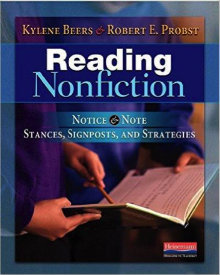Beers & Probst: Nonfiction Signposts & Strategies
Reading Nonfiction: Notice & Note Stances, Signposts, and Strategies
By Kylene Beers and Robert E. Probst
(Heinemann, 2015 – Learn more)

Students’ reading choices should not be limited by a number, a letter or a color code. How refreshing to read this in Reading Nonfiction: Notice & Note Stances, Signposts, and Strategies by Kylene Beers and Robert E. Probst. Text selection for students is so often driven by numbers or letters based on a test.
To support their position, the authors discuss in depth factors connected with readability, complexity and rigor. “Reducing text complexity to a formula based on sentence length and word frequency isn’t the solution. The next time someone requires that you use a Lexile number to match a child with a book, encourage a conversation about the efficacy of this as a sole measure.”

I was caught off guard initially at the Beers-Probst definition of non-fiction.
“Non-fiction is the body of work in which the author purports to tell us about the real world, a real experience, a real person, an idea, or a belief.”
Students have been typically taught that non-fiction means “not fake.” I have made that same mistake in my own classroom. Beers and Probst challenge the reader to enter the text “recognizing that the author is not offering the truth, but one vision of the truth.” In my own classes this challenge will lead me to bring a new perspective when we are reading nonfiction.
The authors continue: “We are required to read beyond the four corners; we are required to let nonfiction intrude; we are required to wonder what it means on the page, in our lives, and in the world.”
5 Signposts can help
The authors contend that “Signposts make the reading of nonfiction more meaningful, more personal.” Each of the five signposts they have identified is arranged with anchor questions, charts, author side comments, and clear steps for teaching and modeling.
- Contrasts and Contradictions – when the author presents something that contrasts or contradicts what the reader is likely to know, think or have experienced, or shows a difference between two or more situations, events or perspectives
- Extreme or Absolute Language – author uses language that leaves no doubt about a situation or event that exaggerates or overstates a case.
- Numbers and Stats – author uses number or words that show amounts or statistical information to show comparisons in order to prove a point or help create an image
- Quoted Words – author quotes others, directly, with what we call a Voice of Authority or Personal Perspective, or citing Others’ Words
- Word Gaps – author uses words or phrases students recognize they don’t know
The graphic images interspersed throughout the chapters are practical hints for application in the classroom. Chapters on signposts will need to be slowly digested in pieces. The authors have written a complete and detailed explanation with examples from various experiences.
The authors also write that “Strategies are those scaffolds we share with kids to make the invisible thinking process visible.” What a perfect explanation of a strategy. The seven strategies are limited for a reason, so that students will learn to use these tools more. My favorite strategy is “Sketch to Stretch.” Visualization is often a problem during reading, so students do three things:
- Underline specific parts of text that cause confusion
- Reread these parts and try to draw in the margin what the author is describing
- Label their drawing with terms used in the text
The other six strategies include:
- Possible Sentences
- KWL 2.0
- Somebody Wanted But So
- Syntax Surgery
- Genre Reformation
- Poster
At the end of the book are appendixes which include surveys, articles, models, booklists and teaching resources.
Reading Nonfiction: Notice and Note is a powerhouse resource of practical strategies and signposts to help all levels of readers. The information will impact and encourage my own classroom. Thank you, Kylene and Robert, for new definitions which challenge my own thinking and practices in the classroom.
Read another review of this book
Sandy Wisneski (@stampcat2) is a lead teacher at Catalyst Charter Middle School in Ripon, WI. She is the district Webmaster, tech mentor, and yearbook advisor as well as new teacher mentor. Over the past 39 years, she has become certified as a Flat Classroom Teacher and obtained her masters in reading. She is also a Graphite Certified Teacher. The summer of 2014 she attended Honeywell Educators @ Space Academy. She enjoys challenging students to “take ownership” for their learning and to be effective digital citizens in the world.

































